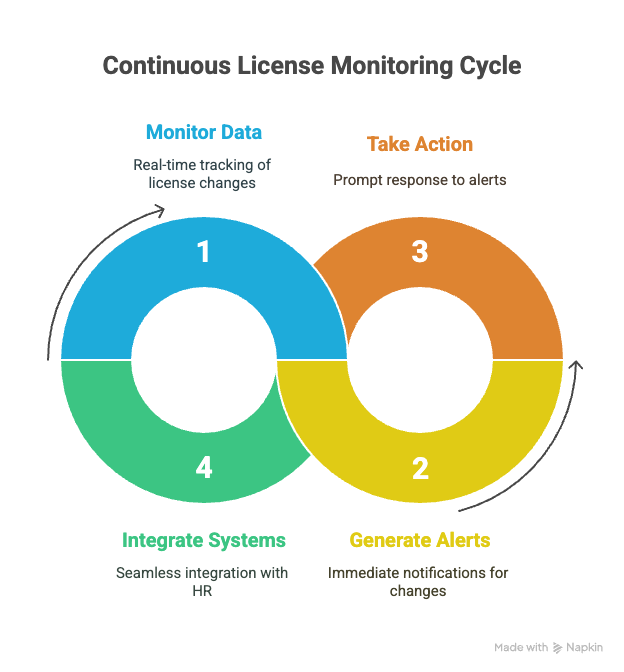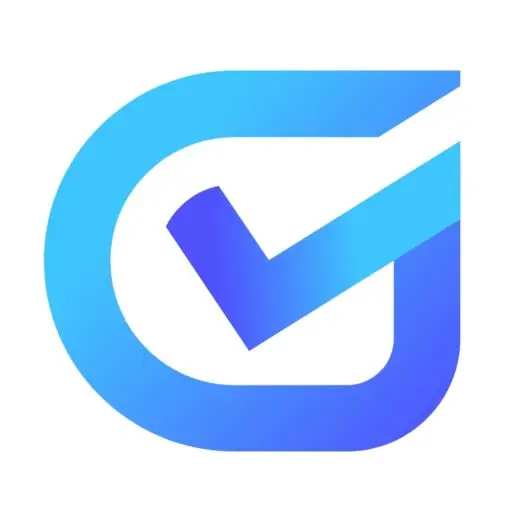In the rapidly evolving world of healthcare, ensuring compliance with professional licensing requirements is paramount. Continuous license monitoring has emerged as a crucial process for healthcare organizations, aiding in maintaining high standards of practice, safeguarding patient safety, and mitigating legal risks.
This guide dives deep into continuous license monitoring in healthcare, examining the benefits and potential drawbacks. Whether you're an HR professional, a healthcare administrator, or a professional seeking to understand the intricacies of license compliance, this comprehensive outline will equip you with valuable insights.
Key Takeaways
- Continuous license monitoring ensures that healthcare professionals maintain valid licenses, reducing legal risks and boosting patient trust.
- By automatically tracking licenses, these systems decrease manual errors and allow for quick corrective actions when issues arise.
- Privacy protection must be prioritized due to the sensitive data involved in the monitoring process.
- Implementing and maintaining such systems require substantial financial investments and dedicated personnel.
- Evaluate whether the benefits of continuous monitoring align with your organization's goals and resources.
Introduction
Continuous license monitoring in healthcare is the ongoing process of verifying that healthcare professionals maintain valid, up-to-date licenses to practice. It's a proactive approach that involves regularly checking licensing credentials to ensure compliance with state and federal regulations.
Healthcare entities face strict compliance requirements, subject to changes in law and policy. Keeping track of licensing is not merely administrative; it's integral to patient safety and organizational integrity. When licenses lapse or face disciplinary actions, patient care and the institution's reputation can be compromised.
This article discusses continuous license monitoring's benefits and drawbacks, shedding light on its impact across the industry. Understanding this balance helps healthcare professionals and administrators make informed decisions within their organizations. Credential checking has moved beyond its original hiring phase to become a standard of care capable of providing real-time access. With properly developed systems, organizations are better positioned to protect their patients, enable their employees, and pre-empt compliance risks. The goal extends beyond legalism; association with unsound practice can permanently damage a hospital's reputation.
EXPERT INSIGHT: After years of operating within the fluid needs of HR, I have learned that compliance is more than just checklists; it's a personal commitment to protecting individuals. In healthcare, where life or death are part of every conversation, careful attention to licenses is not just a matter of avoiding fines—it's a question of trust. I've seen how a missed step can ripple through a facility, impacting morale, safety, even patient care. That's why I advocate a forward-looking approach rather than a backward-looking one—with a sense of responsibility and compassion infused into our processes. Because built into every policy needs to be a abiding concern with those being served. - Charm Paz, CHRP
What is Continuous License Monitoring?
Continuous license monitoring in healthcare involves the ongoing verification of professional licenses and credentials for healthcare providers. Unlike traditional checks done at hiring, this process runs consistently, ensuring regulatory compliance is maintained over time.
The main goal here is to keep up with changing regulations and ensure that healthcare workers are certified. It's about enhancing patient safety by verifying that all practitioners remain qualified to deliver care. Imagine a healthcare facility that doesn't keep track of licensing changes. It risks hiring unqualified staff and facing legal problems. By using continuous monitoring, these risks are minimized.
In this process, data is monitored for changes in real time. If a license is revoked or expires, alerts are generated. This allows immediate action, avoiding potential legal issues and preserving trust with patients and authorities. Emphasizing efficiency, continuous monitoring integrates with existing HR systems, making the process seamless.

For those managing healthcare operations, consider: how does your current system check credentials? Is it reactive, or is it proactive, like continuous monitoring? This approach not only safeguards compliance but also builds a more streamlined, reliable healthcare organization.
The Pros of Continuous License Monitoring
Continuous license monitoring serves as a vital tool for maintaining compliance and elevating patient safety in healthcare. Implementing this practice holds several advantages for organizations.
Ensures Compliance and Reduces Risks
Continuous monitoring is your ally against non-compliance. Regulations shift often, and without real-time oversight, your organization risks hefty fines or legal issues. With continuous license monitoring, you get timely alerts about changes in licensing requirements or expirations. For example, a hospital in California once faced a substantial penalty for having several staff operate with expired credentials. With continuous monitoring, such risks diminish, fostering a compliant organizational culture.
Real-time credential tracking is another pillar of this process. When licenses are up to date, your healthcare professionals can focus solely on patient care. Real-time tracking keeps you informed about the status of each professional's credentials, ensuring no lapse in qualification or authority to practice occurs. The peace of mind this brings to both staff and administration is invaluable.
Enhances Patient Safety
Verifying qualifications are more than a checkbox—it's about safeguarding lives. With continuous monitoring, your active roster only includes fully qualified professionals. This process validates that each doctor, nurse, or technician has the necessary credentials to deliver care, thereby enhancing patient trust and safety.
Sanction alert systems are part and parcel of this approach. They notify you immediately if a healthcare worker faces sanctions or disciplinary actions. For example, alert systems prevented a clinic from unknowingly hiring a surgeon whose license was under investigation. Prompt notifications allow for swift actions, like removing the individual from patient care until the issue is resolved, maintaining service integrity and patient safety.
Streamlines Administrative Processes
Beyond compliance and safety, continuous license monitoring also improves efficiency. By cutting down on manual license checks, it reduces the workload for HR and compliance teams. Automated alerts and real-time updates ensure that your team doesn't waste time sifting through records or chasing expired licenses. This streamlining of processes allows your staff to reallocate their focus to more strategic tasks.
Moreover, these systems can integrate with existing HR platforms, offering centralized data management. Picture a seamless flow where license monitoring data feeds directly into HR databases, reducing duplicate data entry and minimizing error rates. It creates a more cohesive operational environment, simplifying compliance management. This integration streamlines workflows and boosts the overall efficiency of your systems.
Are you ready to embrace this shift in how you handle licensing? Even if you're wary of change, the time and accuracy benefits make a compelling case. How could these efficiencies transform your organization's daily operations?
The Cons of Continuous License Monitoring
Potential Privacy Concerns
When you deal with personal information, privacy becomes a significant issue. Continuous license monitoring in healthcare involves handling sensitive data. There's a risk of unauthorized access if the information isn't managed securely. For example, when monitoring systems store data, you need to ensure that only authorized personnel can access it. If not managed well, breaches could occur, resulting in serious legal repercussions.
One way to mitigate privacy risks is through robust data encryption and access controls. Implement strong authentication methods to control who gets access to the information. Regular audits can also help identify vulnerabilities in your system. Consult privacy guidelines, like those from the DOL, to align with best practices and regulations.
Financial and Resource Implications
Setting up a continuous license monitoring system isn't cheap. There's a financial commitment involved, from the initial setup to regular maintenance. You need to budget for software, hardware, and potential customizations, as well as ongoing fees for system updates and support services. This can be a burden, especially for smaller organizations with limited funds.
Aside from money, resources like personnel are also crucial. These systems require skilled staff for implementation and daily operations. You may need to hire additional employees or train current staff, adding to the overall costs. Balancing resource allocation without stretching your team too thin is vital.
System Limitations and Technical Challenges
Accessing continuous data isn't devoid of technical hurdles. You might face compatibility issues with existing HR systems or deal with software that lacks certain functionalities. Moreover, technology keeps changing, and systems demand frequent updates to remain compliant with new regulations.
You should have a strategy for regular system enhancements to address these gaps. Allocate budget and resources for software upgrades and plan for potential disruptions during these changes. It's essential to work closely with your IT department or an external provider to ensure a seamless integration process and minimize downtime.
Addressing these technical challenges involves ongoing attention and investment. It's a constant balancing act between keeping systems up to date and managing resource allocation. How will your organization tackle these issues?
Recommendations for Implementing Continuous License Monitoring
Start by identifying the specific needs of your organization. Look into factors such as the size of your team, budget constraints, and existing systems. This will help you select a monitoring solution that aligns with your goals. Some systems offer robust features, while others might be more basic yet sufficient for smaller operations.
Once you have chosen a system, training your staff becomes crucial. Employees should know how to use the new tools effectively. Consider holding workshops or training sessions. This not only boosts confidence but also ensures that everyone is on the same page regarding compliance protocols and the significance of continuous monitoring.
Regular audits are essential. Set up a schedule to review the system's performance and ensure it remains relevant as regulations shift. Updates should not be overlooked. They ensure the system functions smoothly and keeps up with legal and technological changes. An audit might reveal gaps in the process, providing an opportunity for improvement.
Are you equipped to handle unforeseen challenges? Consider designating a team member who can troubleshoot or manage system issues promptly. They should be familiar with both the technical and compliance aspects of the system.
Making the right choices can streamline operations and enhance compliance, ultimately supporting the organization's mission of delivering safe, quality care. Each step you take toward effective monitoring builds a stronger foundation for trust and reliability in healthcare services.
Conclusion
Continuous license monitoring in healthcare is a balancing act between benefits and challenges. On the plus side, it ensures compliance, enhances patient safety, and streamlines administration. By keeping up with licensing requirements, healthcare organizations can avoid legal pitfalls. Real-time tracking allows for prompt actions and fewer manual errors, while alert systems highlight disciplinary actions quickly.
However, there are downsides. Privacy concerns loom large, with sensitive data at risk. Financially, these systems require significant investments in setup and maintenance. They also demand dedicated resources and can face technical hurdles that necessitate regular updates.
When considering continuous license monitoring, weigh these factors carefully. The decision should align with your organization’s needs, prioritizing compliance and patient safety. Assess whether the benefits justify the costs and resources involved.
Frequently Asked Questions (FAQs)
What is continuous license monitoring in healthcare?
Continuous license monitoring keeps track of healthcare professionals’ licenses to ensure they renew on time and adhere to regulations. This process helps maintain compliance and ensures that healthcare providers hold valid and up-to-date credentials.
Do hospitals need to track employee licenses in real time?
Yes, hospitals benefit from tracking licenses in real time to promptly address any issues that may arise. Immediate updates help in maintaining compliance and ensuring patient safety.
What are the risks of not monitoring professional licenses?
Not monitoring licenses can lead to expired credentials, resulting in legal issues, fines, or even suspension of operation permits. It may also impact patient safety and trust in the healthcare system.
How much does license monitoring software cost?
License monitoring software costs vary depending on features and the number of licenses managed. Prices can range from a few hundred dollars to several thousand annually. It’s essential to evaluate features against your budget to find the most suitable option.
Can employers monitor licenses without employee consent?
Employers generally need employee consent to access and monitor professional licenses. Check your local regulations and employment agreements to ensure compliance with privacy laws.
How often should licenses be monitored for compliance?
Licenses should be monitored continuously for real-time updates. Set regular intervals for thorough checks, aligning with renewal deadlines and regulatory updates.
What features should you look for in a license monitoring software?
Look for automatic renewal alerts, real-time updates, an easy-to-use interface, and comprehensive reporting capabilities. Software that integrates with existing HR systems can streamline operations.
How can license monitoring improve patient care?
Ensuring that all healthcare providers have current licenses guarantees they meet professional standards. This leads to reliable, high-quality patient care and builds trust in health services.
Are there alternatives to software for license tracking?
Manual tracking and spreadsheets are alternatives, though they are time-consuming and prone to errors. Software offers a more efficient and accurate approach.
Can license monitoring reduce healthcare costs?
By avoiding penalties and ensuring efficient operations, license monitoring can save costs. It also helps in maintaining staff readiness, which supports service continuity and efficiency.
Definitions
Compliance
Compliance refers to your organization's ability to follow laws, regulations, and internal policies. In healthcare, this includes keeping up with licensing rules, training requirements, and reporting standards. Continuous license monitoring helps ensure that healthcare professionals stay qualified, reducing legal and financial risks.
Credentialing
Credentialing is the process of verifying a healthcare professional’s qualifications, such as education, certification, and work history. It confirms that someone is qualified to provide medical care. Continuous license monitoring updates this information in real time, rather than only at the hiring stage.
Sanction Alert
A sanction alert is a notification triggered when a healthcare professional faces disciplinary action on their license. These alerts help you take quick action, such as removing a provider from patient care if needed. They support patient safety and prevent compliance issues.
Real-Time Tracking
Real-time tracking means monitoring licensing data continuously, rather than doing periodic manual checks. For example, if a license expires or is revoked, the system alerts you immediately. This helps you stay ahead of issues before they affect care or compliance.
Integration
Integration is the process of connecting license monitoring systems with your current HR or compliance platforms. When systems work together, data flows automatically between them. This reduces the need for duplicate data entry, lowers error rates, and streamlines your administrative workload.
References
Still have questions?
Get in touch with our team today for a personalized demo and discover how our tailored volume pricing and packages can drive results for your business!
How useful was this page?*
Note: your comments are anonymous. We use them to improve the website. Do not include any personal details.
Visit our FCRA Compliance Tool or leave a message here if you need a response.
From the blog Explore the GCheck Content Hub

How Long Does a Background Check Take? A Complete 2025 Guide
13 Dec, 2023 • 14 min read
The Ultimate Background Check Guide
13 Dec, 2023 • 4 min read
The Ultimate Guide to Employment Background Checks
13 Dec, 2023 • 10 min readThe information provided in this article is for general informational and educational purposes only and should not be construed as legal advice or a substitute for consultation with qualified legal counsel. While we strive to ensure accuracy, employment screening laws and regulations—including but not limited to the Fair Credit Reporting Act (FCRA), Equal Employment Opportunity Commission (EEOC) guidelines, state and local ban-the-box laws, industry-specific requirements, and other applicable federal, state, and local statutes—are subject to frequent changes, varying interpretations, and jurisdiction-specific applications that may affect their implementation in your organization. Employers and screening decision-makers are solely responsible for ensuring their background check policies, procedures, and practices comply with all applicable laws and regulations relevant to their specific industry, location, and circumstances. We strongly recommend consulting with qualified employment law attorneys and compliance professionals before making hiring, tenant screening, or other decisions based on background check information.


